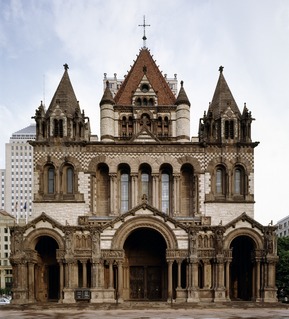
Richardsonian Romanesque is a style of Romanesque Revival architecture named after the architect Henry Hobson Richardson (1838–1886). The revival style incorporates 11th and 12th century southern French, Spanish, and Italian Romanesque characteristics. Richardson first used elements of the style in his Richardson Olmsted Complex in Buffalo, New York, designed in 1870. Multiple architects followed in this style in the late 1800s; Richardsonian Romanesque later influenced modern styles of architecture as well.

Gainesville Masonic Lodge No. 41 in Gainesville, Florida is a historic Masonic building, located at 215 North Main Street. It was constructed by Gainesville Masonic Lodge No. 41 in 1908. On May 29, 1998, it was added to the U.S. National Register of Historic Places.

The former St. Andrew's Episcopal Church building, also known as Old St. Andrew's Event Venue, is an historic building located at 317 Florida Avenue in downtown Jacksonville, Florida. It was originally an Episcopal church, but closed when the parish relocated to the suburbs in 1960. On May 4, 1976, the edifice was added to the U.S. National Register of Historic Places. In the 1990s it was purchased by the City of Jacksonville and turned over to the Jacksonville Historical Society (JHS), and now serves as an event venue managed by the society.

The Calvary Episcopal Church is located at 3766 Clifton Avenue, in the Clifton. It is part of the Clifton Avenue Historic District. Its Sunday School is a historic building listed in the National Register on March 3, 1980.
Rockford is an unincorporated community and former town in southern Surry County, North Carolina.
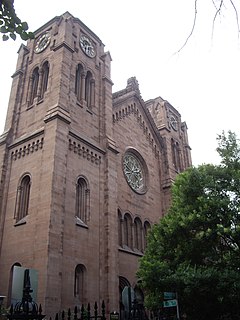
St. George's Episcopal Church is a historic church located at 209 East 16th Street at Rutherford Place, on Stuyvesant Square in Manhattan, New York City. Called "one of the first and most significant examples of Early Romanesque Revival church architecture in America", the church exterior was designed by Charles Otto Blesch and the interior by Leopold Eidlitz. It is one of the two sanctuaries of the Calvary-St. George's Parish.

The Church of the Presidents is a former Episcopal chapel on the Jersey Shore where seven United States presidents worshipped. It was visited by presidents Ulysses S. Grant, Rutherford B. Hayes, James A. Garfield, Chester A. Arthur, Benjamin Harrison, William McKinley, and Woodrow Wilson. All except Grant were in office when they paid their visits to the church.

St. Peter's Episcopal Church, also known as St. Peter's Church, is located in downtown Albany, New York, United States. It was designed in the mid-19th century by Richard Upjohn and his son Richard M. Upjohn in the French Gothic Revival architectural style. It was listed on the National Register of Historic Places in 1972, and designated a National Historic Landmark eight years later. It is also a contributing property to the Downtown Albany Historic District.
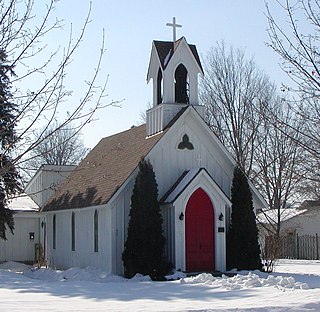
The Church of the Advent built in 1872 is a historic Carpenter Gothic Episcopal church located at 412 Oak Street, in Farmington, Minnesota, in the United States. On December 31, 1979, it was added to the National Register of Historic Places.

This is a list of the National Register of Historic Places listings in Dakota County, Minnesota. It is intended to be a complete list of the properties and districts on the National Register of Historic Places in Dakota County, Minnesota, United States. Dakota County is located in the southeastern part of the U.S. state of Minnesota, bounded on the northeast side by the Upper Mississippi River and on the northwest by the Minnesota River. The locations of National Register properties and districts for which the latitude and longitude coordinates are included below, may be seen in an online map.
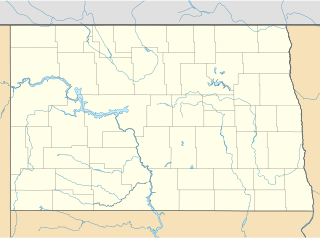
The former St. Alban's Episcopal Church is an historic stone Late Gothic Revival-style Episcopal church located on the southwest corner of Hammond and Eastern avenues in Lidgerwood, North Dakota. On December 3, 1992, it was added to the National Register of Historic Places. As of that date, the building housed Harmony Lodge No. 53 of the Ancient, Free & Accepted Masons. Harmony Lodge, founded in 1899, surrendered its charter in 1994.

The former St. Stephen's Episcopal Church also known as St. Stephen's Church, is an historic stone Gothic Revival-style Episcopal church building located on the southeast corner of 3rd Avenue and 5th Street in Casselton, North Dakota, United States.

The old First Methodist Episcopal Church, also known as First Methodist Episcopal Church, South, is a historic redbrick Southern Methodist church building located at 400 Broadway in Pueblo, Colorado. Designed by George W. Roe in the Romanesque Revival style of architecture, it was built in 1902. In 1939 it became the Trinity Methodist Church. Bought by the George F McCarthy Funeral Home in 1954, it is now the George McCarthy Historic Chapel and is used for funeral services.

Trinity Church is a historic Episcopal church located at Elkridge, Howard County, Maryland. The post road site was also known as Waterloo, Pierceland, Jessop and Jessup throughout the years.

The Mechanicsburg Baptist Church is a historic church in the village of Mechanicsburg, Ohio, United States. Constructed for a Methodist congregation in the late nineteenth century, the building was taken over by Baptists after the original occupants vacated it, and it has been named a historic site.

The 1916 Buffalo High School, also known as Buffalo-Tower City Senior High School, is a property in Buffalo, North Dakota that was listed on the National Register of Historic Places (NRHP). It is located near the center of Buffalo, near the Old Stone Church which is also NRHP-listed.
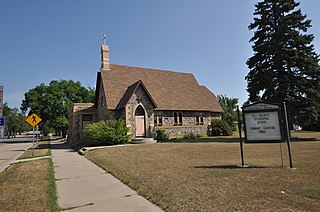
All Saints' Episcopal Church built in 1881 is a historic Episcopal church building located in Valley City, Barnes County, North Dakota. Designed in the Late Gothic Revival style of architecture by an unknown architect, it was built of local fieldstone with concrete mortar and a wooden shake roof. It is noted as the "first stone Episcopal church [built] in North Dakota." On December 3, 1992, it was added to the National Register of Historical Places as part of the Episcopal Churches of North Dakota Multiple Property Submission.

Grace Episcopal Church is a historic Episcopal church building is located at 210 C Avenue, South, in Minnewaukan, Benson County, North Dakota.

Grace Episcopal Church is an historic Episcopal church building located at 152 Ramsey Street, West in Pembina, Pembina County, North Dakota. Designed in the Late Gothic Revival style of architecture by Fargo architect George Hancock, it was built in 1886. Unlike all the other churches in the Episcopal Churches of North Dakota Multiple Property Submission (MPS), it was built of brick instead of local fieldstone. The brick is yellow and was made locally by the Pembina Brick Company. The church building is one of only three extant building built of this brick. In 1937 Grace Church closed due to declining attendance and the building was sold by the Episcopal Diocese of North Dakota to the local Methodist congregation. Today it is the Pembina Pioneer Memorial United Methodist Church. On September 2, 1994, the building was added to the National Register of Historic Places as Grace Episcopal Church.

The Stratford Methodist Episcopal Church is a historic former church building located near the city of Delaware, Ohio, United States. Constructed in the 1840s for workers in a company town, it was home to a congregation of the Methodist Episcopal Church until the community faltered following the company's closure. Situated at the southern end of the company town, it remains prominent because of its architecture, and it has been named a historic site.




















